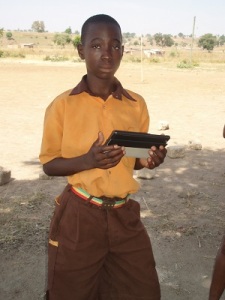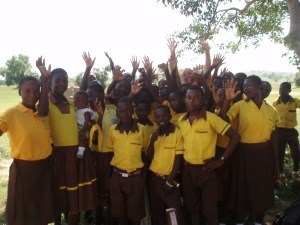On December 2nd 2015 Zopeliga Primary School teachers along with form 5 and 6 students organized a food day at their school. They prepared two foods: ngbegira (beans cakes) and tentaareh (chips from beans flour).

The first dish was Ngebegira. The ingredients needed to prepare this dish were the following: cowbeans (soaked overnight), water, sheabutter, onions, saltbitter and pepper.
The soaked beans were ground and then saltbitter was added to it. The children rolled small cakes out of the dough and put them to cook on clean grass on top of boiling water. The cooking took place over hot steam for about 20 minutes.
Until the cakes were cooking, the students prepared the sauce: melted and heated sheabutter mixed with small slices of onion. The natural taste of sheabutter and onion did not need any other spices added to it.
Once the cakes and the sauce was ready the cake should be dipped into additional pepper (if needed, spices up the taste) and the sauce and it is ready for savoring!
Take a loot at the whole process explained by Zopeliga’s students.
Before the students started the second dish we had a nice talk about food: the students introduced themselves, explained who cooks at home, what they like to eat in general. The discussion was interesting and took place outdoors, hence you can hear the Harmattan winds blowing and how the nature has tried up.
The second dish, tentaareh was unfamiliar for many teachers too, the dish originally comes from Zuarungu area between Kongo village and Bolgatanga town. For this food the students used ready made beans flour that they mixed with salt and water. The paste was smeared on a then placed again inside a pot with clean grass and boiling water. The cooking process was similar to ngbegira, they used hot steam, but the cooking was a lot faster. The cooked dish was then scraped from the walls of the calabash with a spoon and could be eaten as a side dish for dinner or as lunch.
The Zopeliga cooking event was as success not only because the students could show their skills and teach them to the Estonian volunteer who could then in return try to prepare it at home with Estonian students, but local teachers also learned more about their own culture. Both teacher Alice and Mary were positively surprised and wanted to cook it also for their own children.









 As in Väike-Maarja we also have a vocational school, Liina held a cooking course for vocational students and their supervisors. Together they prepared a Ghanaian dish called „red-red“ that was served with fried bananas. The participants all agreed – the result was delicious. Liina had only positive words about the active cookers, who were even ready to take a next cooking lesson by the end of the class.
As in Väike-Maarja we also have a vocational school, Liina held a cooking course for vocational students and their supervisors. Together they prepared a Ghanaian dish called „red-red“ that was served with fried bananas. The participants all agreed – the result was delicious. Liina had only positive words about the active cookers, who were even ready to take a next cooking lesson by the end of the class.






































